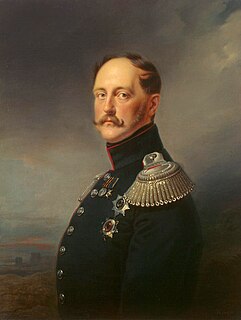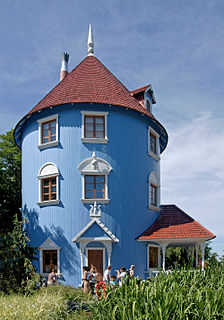Sanoma Corporation is a media group in the Nordic countries with operations in over 10 European countries, based in Helsinki. The group is also among the top five European magazine publishers and has a strong position in Finland as well as in Belgium, Croatia, the Czech Republic, Denmark, Estonia, Hungary, Latvia, Lithuania, the Netherlands, Russia, Serbia, Slovakia, and until 2015 in Ukraine.
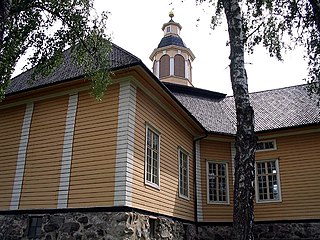
Nastola is a former municipality of Finland. It was merged to the city of Lahti on 1 January 2016.

The Cape Lookout Lighthouse is a 163-foot high lighthouse located on the Southern Outer Banks of North Carolina. It flashes every 15 seconds and is visible at least 12 miles out to sea and up to 19 miles. The Cape Lookout Light is one of the very few lighthouses that operate during the day. It became fully automated in 1950. The Cape Lookout Lighthouse is the only such structure in the United States to bear the checkered daymark, intended not only for differentiation between similar light towers, but also to show direction. The center of the black diamonds points in a north-south direction, while the center of the white diamonds points east-west.
The ISU World Synchronized Skating Championships (WSSC) are the world championships for the sport of synchronized skating. Held since 2000, the World Synchronized Skating Championships is an annual event organized by the International Skating Union and attracts the most elite senior-level synchronized skating teams from around the world to compete for the World Championship.
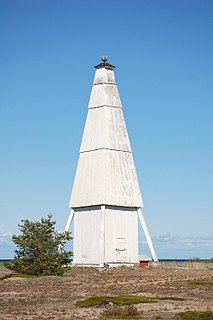
The Keskiniemi beacon tower, often referred to as the Karvo beacon tower, is a historic daymark located on a promontory of Keskiniemi in the northwestern part of Hailuoto island in the Gulf of Bothnia in Finland. The tower was built in 1858 to alert the vessels about sandbars reaching northwest from the site. It is the oldest surviving navigational aid on Hailuoto island. The tower has structural similarities with the Härkmeri beacon tower built in 1857.

Laitakari beacon tower is a daymark located on the island of Laitakari in the Gulf of Bothnia in Finland. The island is located east-northeast of Hailuoto and is within the municipal boundaries of the City of Oulu. There has been a navigational aid on the island since the 1750s, and a beacon tower has been marked on a chart dated in 1785.
Tasku beacon tower is a daymark tower located on the island of Tasku in the Raahe archipelago in the Gulf of Bothnia in Finland. The structure was built in 1853 from the plans drawn by Albin Stjerncreutz. In 1983 the Finnish Maritime Administration handed it over to the City of Raahe. Currently the city is responsible of the upkeep of this historical aid to navigation. The Tasku beacon tower is one of three historical beacon towers in Raahe archipelago, however only two beacon towers remain: the second one is the Iso-Kraaseli beacon tower.
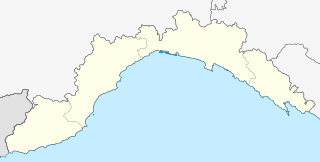
The Lighthouse of Genoa, is the main lighthouse for the city's port. Besides being an important aid to night navigation in the vicinity, the tower serves as a symbol and a landmark for the City of Genoa. Built of masonry, at 249 feet (76 m) it is the world's fifth tallest lighthouse and the second tallest "traditional" one. Between 1543 and the construction of the lighthouse on Île Vierge, France in 1902, it was the tallest lighthouse in the world. When measured as a whole with the natural rock on which it stands, as it is commonly perceived and represented, its height is 383 feet (117 m), which would make it the second tallest lighthouse in the world, the tallest in Europe, and the tallest traditional lighthouse.

Creal Reef Light is an active lighthouse located at Creal Reef, a planar reef about 150 kilometres (93 mi) east of Mackay, Queensland, Australia. It guides ships outgoing from Mackay into Hydrographers Passage, a deep water channel east of Mackay. The structure is a stainless steel tower, which also serves as a daymark and carries a racon.

The Katainen Cabinet was the 72nd cabinet of Finland, formed as a result of the 2011 post-parliamentary election negotiations between the Finnish parliamentary parties. Led by Prime Minister Jyrki Katainen of the National Coalition Party (NCP), 12 ministers of the 19-minister government represented the NCP and the Social Democratic Party (SDP), while the Left Alliance, the Green League, the Swedish People's Party (RKP) and the Christian Democrats share seven minister portfolios. On June 22, the Parliament confirmed Katainen's election as the Prime Minister and President Tarja Halonen inaugurated the government. Two Left Alliance MPs voted against Katainen, for which they were formally reprimanded by the Left Alliance's parliamentary group. On 25 March, 2014, the rest of Left Alliance left the cabinet over dispute on a package of spending cuts and tax rises.
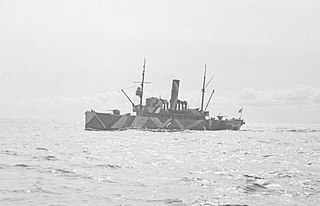
Louhi was a Finnish Navy minelayer. The ship was originally constructed for the Imperial Russian Navy but was taken over by the Finns during the Russian Civil War. She had originally been named Voin, but was renamed as M1 in Finnish service. In 1936 she was given the more personal name Louhi, following the procedure of all other major ships in the Finnish navy.

Lågskär Lighthouse is an automated lighthouse located on the north side of Lågskär, one of Finland's Åland Islands in the Sea of Åland of the Baltic. It is the only striking feature on Lågskär on the generally uninhabited island.

Viiskulma is a well known intersection of five streets in Helsinki at the boundary of the Punavuori and Ullanlinna neighbourhoods. The street Fredrikinkatu is one of the oldest and major traffic arteries of Helsinki's inner city.

Finnair Flight 915 (AY915) was a scheduled flight by Finnair from Tokyo, Japan, over the North Pole to Helsinki, Finland, on 23 December 1987. In 2014, Finnish media reported a claim by two of the flight’s pilots that the Soviet Union had fired a missile at the aircraft, which exploded less than 30 seconds before impact. The allegations came out only in September 2014, when Helsingin Sanomat, the leading Finnish daily newspaper, published an extensive article on the matter. The Finnish Broadcasting Corporation YLE reported on the article in the internet the same day.

Osmussaar lighthouse is a lighthouse on the northwestern peak of Osmussaar.

Sõrve lighthouse is a lighthouse located in Torgu Parish, on the island of Saaremaa, in Estonia. The current lighthouse is a cylindrical concrete tower, which was built to replace a temporary wooden structure lighthouse that served as a signal point between 1945 and 1960.
Division No. 1, Subdivision B is an unorganized subdivision on the Avalon Peninsula in Newfoundland and Labrador, Canada. It is in Division 1 and contains the unorganized communities of Iona, Little Barasway, Placentia Junction, Point Verde and Ship Harbour.
The Krasnyi Bor dump site is a hazardous waste landfill site in Krasny Bor, Tosnensky District, Leningrad Oblast, Russia. The site is sometimes called the "chemical Chernobyl", due to the two million tons of chemical waste accumulated there.

The San Cristóbal lighthouse is an active lighthouse on the Spanish island of La Gomera in the Canary islands. The current lighthouse is the second to have been constructed on the rocky headland of Punta de San Cristóbal, on the eastern side of the island, overlooking the approaches to San Sebastián de La Gomera, the main port and capital of La Gomera.




